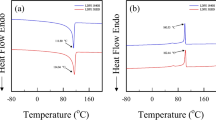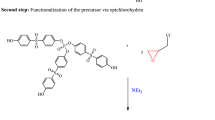Abstract
The linear viscoelastic properties of two series of Ziegler–Natta and metallocene HDPEs (ZN-HDPEs and m-HDPEs, respectively) of broad molecular weight distribution (MWD) have been studied. Correlations between zero-shear viscosity and molecular weight and molecular weight distribution show that the breadth of the MWD for m-HDPEs plays a role. Other interesting correlations between the crossover modulus and steady-state compliance with MWD of both these classes of polymers have also been derived. Finally, the steady-shear viscosities from capillary rheometry are compared with LVE data to check the applicability of the empirical Cox–Merz rule. It is shown that the original Cox–Merz rule is applicable for the ZN-HDPEs, while it apparently fails for the m-HDPEs. However, once the capillary data for m-HDPEs are corrected for slip effects, the applicability of the Cox–Merz rule is validated for their case as well.














Similar content being viewed by others
References
Agarwal PK (1979) A relationship between steady state shear compliance and molecular weight distribution. Macromolecules 12:342–344
Aguilar M, Martin S, Vega JF, Muñoz-Escalona A, Martinez-Salazar J (2005) Processability of a metallocene-catalyzed linear PE improved by blending with a small amount of UHMWPE. J Polym Sci Part B Polym Phys 43:2963–2971
Akovali G (1967) Viscoelastic properties of polystyrene. J Polym Sci Part A2 5:875
Benham EA, McDaniel MP (2006) “Ethylene polymers, HDPE” Kirk-Othmer encyclopedia of chemical technology, 5th edn, vol 20. Wiley, Hoboken
Borg T, Paakkonen EJ (2009) Linear viscoelastic models part III. Start-up and transient flow effects from the molecular weight distribution. J Non-Newton Fluid Mech 159:17–25
Carella JM (1996) Comparison of the rheological properties of metallocene-catalyzed and conventional high-density polyethylenes–comment. Macromolecules 29:8280–8281
Carella JM, Gotro JT, Graessley WW (1986) Thermorheological effects of long-chain branching in entangled polymer melts. Macromolecules 19:659–667
Cho HS, Choi KH, Choi DJ, Lee WY (2000) Control of molecular weight distribution (MWD) for polyethylene catalyzed over Ziegler–Natta/Metallocene hybrid catalysts. Korean J Chem Eng 17:205–209
Cocchini F, Nobile MR (2003) Constrained inversion of rheological data to molecular weight distribution for polymer melts. Rheol Acta 42:232–242
Cox WP, Merz EH (1958) Correlation of dynamic and steady-flow viscosities. J Polym Sci 28:619–622
Dealy JM, Larson RG (2006) Structure and rheology of molten polymers—from structure to flow behavior and back again. Hanser, Munich
Dealy JM, Wissbrun KF (1990) Melt rheology and its role in plastics processing. Van Nostrand Reinhold, New York
den Doelder J (2006) Viscosity and compliance from molar mass distributions using double reptation models. Rheol Acta 46:195–210
des Cloizeaux J (1988) Double reptation vs simple reptation in polymer melts. Europhys Lett Phys 5:437–442
des Cloizeaux J (1990) Relaxation of entangled polymers in melts. Macromolecules 23:3992–4006
Fernandez M, Vega JF, Santamaría A, Muñoz-Escalona A, Lafuente P (2000) The effect of chain architecture on “sharkskin” of metallocene polyethylenes. Macromol Rapid Commun 21:973–978
Gabriel C, Münstedt H (2002) Influence of long-chain branches in polyethylenes on linear viscoelastic flow properties in shear. Rheol Acta 41(3):232–244
García-Franco CA, Mead DW (1999) Rheological and molecular characterization of linear backbone flexible polymers with the Cole-Cole model relaxation spectrum. Rheol Acta 38:34–47
Graessley WW (1982) Effect of long branches on the temperature-dependence of viscoelastic properties in polymer melts. Macromolecules 15:1164–1167
Hatzikiriakos SG (2000) Long chain branching and polydispersity effects on the rheological properties of polyethylenes. Polym Eng Sci 40:2279–2287
Hua CC (2000) Investigations on several empirical rules for entangled polymers based on a self-consistent full-chain reptation theory. J Chem Phys 112:8176–8186
Ianniruberto G, Marrucci G (1996) On compatibility of the Cox-Merz rule with the model of Doi and Edwards. J Non-Newton Fluid Mech 65:241–246
Kanev D, Takacs E, Vlachopoulos J (2007) Rheological evaluation and observations of extrusion instabilities of biodegradable polyesters. Int Polym Process 22:395–401
Kato H, Ichitsubo T, Igarashi H, Inoue A (2009) Correlation of dynamic and quasistatic relaxations: the Cox–Merz rule for metallic glass. Appl Phys Lett 95:231911
Kazatchkov IB, Bohnet N, Goyal SK, Hatzikiriakos SG (1999) Influence of molecular structure on the rheological and processing behaviour of polyethylene resins. Polym Eng Sci 39:804–815
Kazatchkov IB, Hatzikiriakos SG, Stewart CW (1995) Extrudate distortion in the capillary/slit extrusion of a molten polypropylene. Pol Eng Sci 35:1864–1871
Kurata M (1984) Effect of molecular weight distribution on viscoelastic properties of polymers. 2. Terminal relaxation time and steady state compliance. Macromolecules 17:895–898
Liang R (2007) Processing flow behavior and modeling of polyethylene melts. J Cent South Univ Technol 14:178–182
Liu C, Wang J, He J (2002) Rheological and thermal properties of m-LLDPE blends with m-HDPE and LDPE. Polymer 43:3811–3818
Marrucci G (1996) Dynamics of entanglements: a nonlinear model consistent with the Cox-Merz rule. J Non-Newton Fluid Mech 62:279–289
Mavridis H, Shroff RN (1992) Temperature-dependence of polyolefin melt rheology. Polym Eng Sci 32:1778–1791
Mieras HJMA, Rijn CFH (1968) Elastic behaviour of some polymer melts. Nature 218:865–866
Mills NJ (1968) Elasticity of polydimethylsiloxane melts. Nature 219:1249–1250
Mills NJ (1969) The rheological properties and molecular weight distribution of polydimethylsiloxane. Eur Polym J 5:675–695
Mills NJ, Nevin A (1971) Oscillatory shear measurements on polystyrene melts in the terminal region. J Polym Sci Part A2 9:267–281
Milner ST (1996) Relating the shear-thinning curve to the molecular weight distribution in linear polymer melts. J Rheol 40:303–315
Muñoz-Escalona A, Lafuente P, Vega JF, Santamaría A (2000) Rheology of metaIlocene-catalyzed monomodal and bimodal polyethylenes. Polym Eng Sci 39:2292–2303
Nobile MR, Cocchini F (2000) Predictions of linear viscoelastic properties for polydisperse entangled polymers. Rheol Acta 39:152–162
Nobile MR, Cocchini F (2008) A generalized relation between MWD and relaxation time spectrum. Rheol Acta 47:509–519
Onogi S, Masuda T, Kitagawa K (1970) Rheological properties of anionic polystyrenes. I. Dynamic viscoelasticity of narrow-distribution polystyrenes. Macromolecules 3:109–116
Park HE, Lim ST, Smillo F, Dealy JM, Robertson CG (2008) Wall slip and spurt flow of polybutadiene. J Rheol 52:1201–1239
Pattamaprom C, Larson RG (2001) Predicting linear viscoelastic properties of monodisperse and polydisperse polystyrenes and polyethylenes. Rheol Acta 40:516–532
Peacock AJ (1990) Handbook of polyethylene: structures, properties and applications. Marcel Dekker, New York
Prest WM (1970) Viscoelastic properties of blends of entangled polymers. J Polym Sci A2 Polym Phys 8:1897
Prest WM, Porter RS (1973) Rheological properties of poly(2,6-dimethylphenylene oxide- polystyrene blends. J Polym Sci A2 Polym Phys 10:1639
Raju VR, Rachapudy H, Graessley WW (1979a) Melt rheology of linear and star-branched hydrogenated polybutadiene. J Polym Sci 17:1223–1235
Raju VR, Smith GG, Marin G, Knox JR, Graessley WW (1979b) Properties of amorphous and crystallizable hydrocarbon polymers. I. Melt rheology of fractions of linear polyethylene. J Polym Sci Polym Phys Ed 17:1183–1195
Resch JA, Stadler FJ, Kaschta J, Münstedt H (2009) Temperature dependence of the linear steady-state shear compliance of linear and long-chain branched polyethylenes. Macromolecules 42:5676–5683
Rosenbaum EE, Hatzikiriakos SG (1997) Wall slip in the capillary flow of molten polymers subject to viscous heating. AIChE J 43:598–608
Santamaría A, Fernandez M, Sanz E, Lafuente P, Muñoz-Escalona A (2003) Postponing sharkskin of metallocene polyethylenes at low temperatures: the effect of molecular parameters. Polymer 44:2473–2480
Stadler FJ, Münstedt H (2008) Numerical description of shear viscosity functions of long-chain branched metallocene-catalyzed polyethylenes. J Non-Newton Fluid Mech 151:129–135
Stadler FJ, Nishioka A, Stange J, Koyama K, Münstedt H (2007) Comparison of the elongational behavior of various polyolefins in uniaxial and equibiaxial flows. Rheol Acta 46:1003–1012
Stadler FJ, Piel C, Kaschta J, Rulhoff S, Kaminsky W, Münstedt H (2006) Dependence of the zero shear-rate viscosity and the viscosity function of linear high density polyethylenes on the mass-average molar mass and polydispersity. Rheol Acta 45:755–764
Tsenoglou C (1991) Molecular weight polydispersity effects on the viscoelasticity of entangled linear polymers. Macromolecules 24:1762–1767
Tuminello WH (1986) Molecular-weight and molecular-weight distribution from dynamic measurements of polymer melts. Polym Eng Sci 26:1339–1347
Utracki LA, Gendron R (1984) Pressure oscillation during extrusion of polyethylenes II. J Rheol 28:601–623
Utracki LA, Schlund B (1987) Linear low density polyethylenes and their blends. Part 2. Shear flow of LLDPE’s. Polym Eng Sci 27:367–379
Van Krevelen DW (1990) Properties of polymers, 3rd edn. Elsevier, New York
Vega JF, Muñoz-Escalona A, Santamaría A, Muñoz ME, Lafuente P (1996) Comparison of the rheological properties of metallocene-catalyzed and conventional high-density polyethylenes. Macromolecules 29:960–965
Venkatraman S, Okano M, Nixon A (1990) A comparison of torsional and capillary rheometry for polymer melts: the Cox–Merz rule revisited. Polym Eng Sci 30:308–313
Vinogradov GV, Malkin AY (1980) Rheology of polymers. Mir, Moscow
Wasserman SH, Graessley WW (1996) Predictions of linear viscoelastic response for entangled polyolefin melts from molecular weight distributions. Polym Eng Sci 36:852–861
Winter HH (2009) Three views of viscoelasticity for Cox–Merz materials. Rheol Acta 48:241–243
Wood-Adams PM, Dealy JM, deGroot AW, Redwine OD (2000) Effect of molecular structure on the linear viscoelastic behavior of polyethylene. Macromolecules 33:7489–7499
Zeichner GR, Patel PD (1981) A comprehensive evaluation of polypropylene melt rheology. In: Proc 2nd world congr of chem eng. Montreal
Author information
Authors and Affiliations
Corresponding author
Rights and permissions
About this article
Cite this article
Ansari, M., Hatzikiriakos, S.G., Sukhadia, A.M. et al. Rheology of Ziegler–Natta and metallocene high-density polyethylenes: broad molecular weight distribution effects. Rheol Acta 50, 17–27 (2011). https://doi.org/10.1007/s00397-010-0503-4
Received:
Revised:
Accepted:
Published:
Issue Date:
DOI: https://doi.org/10.1007/s00397-010-0503-4




